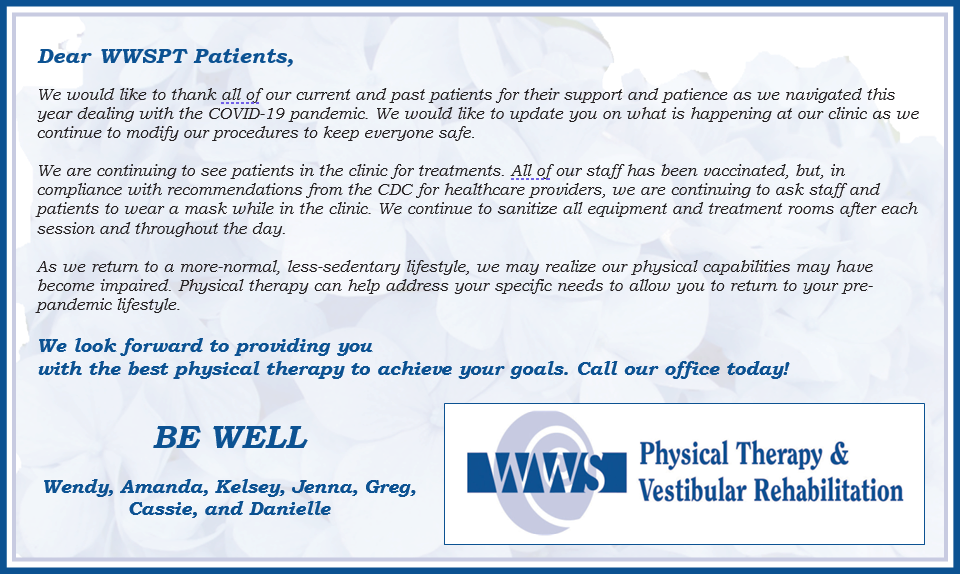
Dear WWS Physical therapy and VestibularRehabilitation Patients,

Healing, Function, Recovery, Health

The COVID-19 pandemic has changed our day-to-day lives for the past year. The virus is a severe acute respiratory syndrome coronavirus (SARS-CoV-2). Its rapid spread caused over 4 million deaths around the globe, changing the landscape of medicine forever.
Although the clinical features observed in COVID-19 patients mostly affect the respiratory and circulatory systems, there is mounting evidence about the neurological manifestations that impact nearly 30% of COVID-19 patients.
Common symptoms of COVID-19 include cough, fever, fatigue, body aches, and G.I. distress. Neurological symptoms reported in 30% of patients include loss of smell, loss of taste, migraine headaches, and dizziness. This is not surprising since dizziness is associated with viral infections of the inner ear.
Dizziness is a broad term and can mean different things to different patients. Dizziness described as lightheadedness can mean feeling like you are about to faint or feel unsteady when walking. In a study by Viola et al, 18% of COVID-19 patients complained of dizziness. Of those patients, 8% experienced lightheadedness, 8% had imbalance with walking, and 2% felt the true spinning of vertigo. In the study, 23% of patients reported symptoms of tinnitus (ringing in the ear), which was intermittent or constant in nature.
Is dizziness specifically caused by a COVID-19 infection? The quarantine lifestyle that we have been forced to adopt over the last year may also be a factor. The change in normal activity levels has specifically affected our senior population, which was most at risk. They went out much less, limiting their activities to walking around their home—for less than when they were out and about in their communities prior to the pandemic. The reduced socialization activities such as going to the food store, walking around a shop, going to the doctor’s office, and visiting with the family have taken their toll on the senior population, leading to decreased endurance for ambulation and reduced strength. For a population already prone to falls, this consequence of the pandemic can put seniors at higher risk of falling.
In addition, patients who did contract COVID-19 may have impaired breathing, which can cause patients to feel lightheaded with exertion. Inadequate circulation due to COVID-related cardiac problems can cause low blood pressure and impair the amount of oxygen circulated to the brain, which leads to dizziness. These patients would benefit from a supervised exercise program to work on endurance and balance, which can be provided by a Physical Therapist.
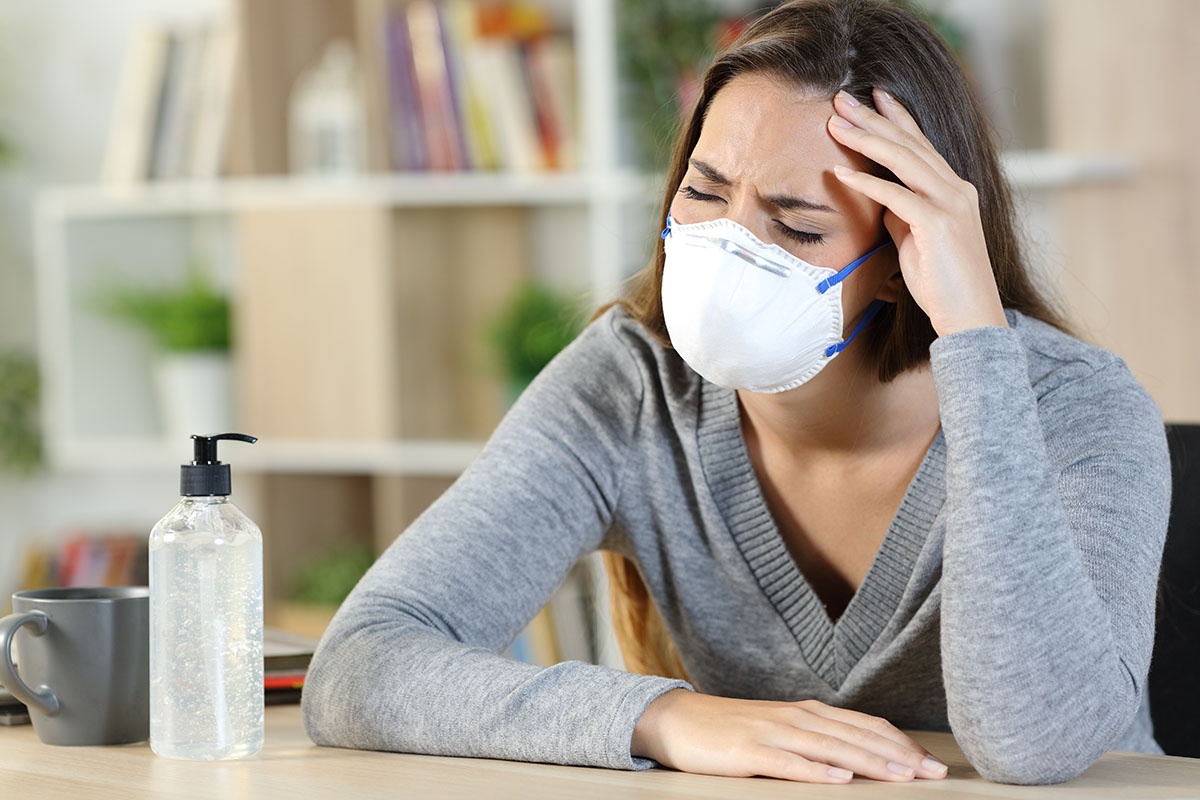
Vertigo and Migraine Headaches
Vertigo, a false sense of movement with spinning and feeling off-balance, is something that we commonly treat at WWSPT. We specialize in the care of disorders related to the vestibular system—most commonly vertigo. Since the pandemic began, we have seen an increase in vertigo-associated disorders and migraine-associated vertigo referred to our clinic. Many vertigo-related disorders are in post- COVID patients.
BPPV, a mechanical disorder of the inner ear where crystals are displaced causing acute vertigo, may develop within weeks after a COVID-19 infection, manifesting with short attacks of vertigo and spinning with associated nausea and vomiting. Vestibular Rehabilitation is effective in the treatment of BPPV, with maneuvers designed to move displaced crystals back to the proper place in the inner ear and reduce vertigo attacks.
Headache has been reported as the first symptom in 26% of people with COVID-19, and it presented within 24 hours for 62% of people with the virus. One-quarter of these patients have a headache that resembles a migraine, and 54% experience what resembles a tension-type headache.
Migraine headaches are a common neurological symptom, and changes in lifestyle due to the pandemic can influence the frequency of migraines and headaches. Changes in our work settings and hours, increases in screen time at home, increases in stress, and disruption in sleep, and regular exercise patterns all affect the frequency of migraines. Working at temporary desks and using poor posture can lead to tension headaches and cervical pain. In the early months of the pandemic, we saw many patients in the clinic for whom we were able to help make simple adjustments to their work-from-home setup to reduce migraine headaches.
A vestibular migraine is a common form of migraine that doesn’t always have a headache associated with it but can have other vestibular symptoms such as vertigo, nausea, light and sound sensitivity, and imbalance which are just as disabling as a headache. Many of the same triggers for migraine headaches can cause a vestibular migraine, but it is not as well recognized.
In a small set of post- COVID patients, headaches seem to linger long after the illness is over. They may benefit from pharmacological interventions and should see a neurologist for consultation.
An acute vestibular presentation in COVID-19 patients is “COVID-19 induced neuritis” of the vestibular nerve. These patients have sudden-onset severe vertigo, nausea, vomiting, and difficulty walking, without typical symptoms of fever or cough. These patients often need hospitalization and medical management before getting referred to vestibular rehabilitation.

Vestibular rehabilitation is effective in reducing symptoms of vertigo, visual-head motion sensitivity, and motion sickness. Exercise programs are designed to help overcome the false perception of movement due to errors in signals between the inner ear and the brain and to regain normal balance reactions. Coronavirus has challenged our lifestyles, health, and emotional well-being. Medical professionals and researchers continue to gather new information about the COVID-19 virus and how to manage post- COVID symptoms. Lingering symptoms of COVID such as dizziness, pain, and shortness of breath can continue to disrupt your life and limit you from returning to your normal activities. If you are experiencing any of these symptoms, consider a consultation at WWSPT with our Vestibular Physical Therapists.
Wendy Webb Schoenewald, PT, OCS, at
WWS Physical Therapy and Vestibular Rehabilitation
Doylestown, PA., 215-489-3234, wwspt@wwspt.com
One year after we entered the Public Health Emergency of COVID-19 pandemic, researchers are gathering information about common symptoms associated with patients post covid episodes. Thirty percent of post-COVID patients have some form of neurological symptoms which include common vestibular symptoms of dizziness, vertigo, balance issues, and earaches. Sometimes these symptoms are short term but they can also persist for 4-8 weeks afterward
Most of us are aware of the most common neurological symptoms of ageusia, lack of taste and anosmia, lack of smell, which are both cranial nerves with direct input to the brain. The vestibular nerve which is also a cranial nerve for the inner ear is also affected in a smaller population, approximately 0.6%. Patients with vestibular symptoms are frequently referred to WWSPT since we are experts in the field of Vestibular Rehabilitation. Most have complaints of lightheadedness, headaches, and dizziness but researchers have found up to 6% having acute vertigo attacks.
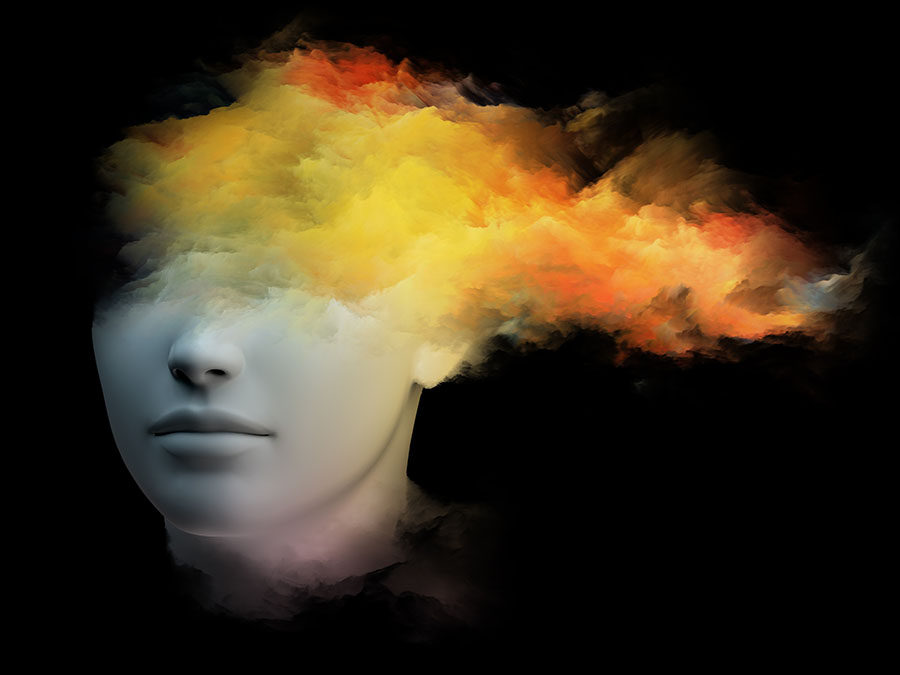
Headaches and dizziness can also be associated with Brain fog. What is “Brain fog”? it is not a medical condition. It’s a term used for certain symptoms that can affect your ability to think. You may feel confused or disorganized or find it hard to focus or put your thoughts into words. Brain fog is a common vestibular symptom and now is also being associated with post covid symptoms, your vestibular therapist can help!!
The article below gives more information about post covid symptoms and brain fog.
Winter has arrived in our area of Eastern Pennsylvania; and in Bucks and Montgomery Counties, we all know that means Snow and Ice. For seniors, snow and ice mean an increased risk of injury and other possible complications. More specifically, the rate of falls is elevated in the winter. This makes many of our older adults hesitant to leave the home.
How can we avoid some of these common winter injuries?
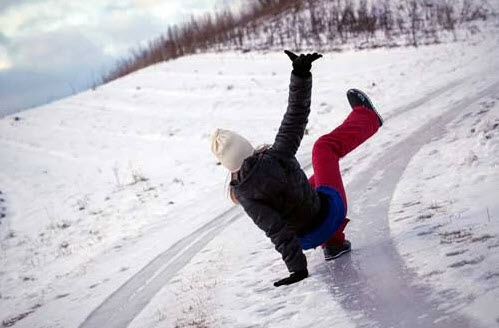
Watch out for Black Ice. Keep a close eye on areas that are prone to ice build-up and be sure to use salt in these locations as needed. If you are in a position where you may encounter ice wear new shoes with good, rubber treads. This will help to promote better traction and ensure better grip. Taking smaller steps at a slower speed will also allow you to regain your balance more easily should you start to slip.
Lifting and shoveling snow: After a large snowfall, many of us wake up the next morning with aches and pains, particularly in our backs. When shoveling snow, be sure to be aware of your posture. Try keeping your feet apart, creating a wider base of support. Maintain a flat back and bend through your knees, rather than flexing forward. When moving the snow, try to avoid twisting or rotating, which may irritate your back as well. When possible try to push the snow rather than throwing the snow.
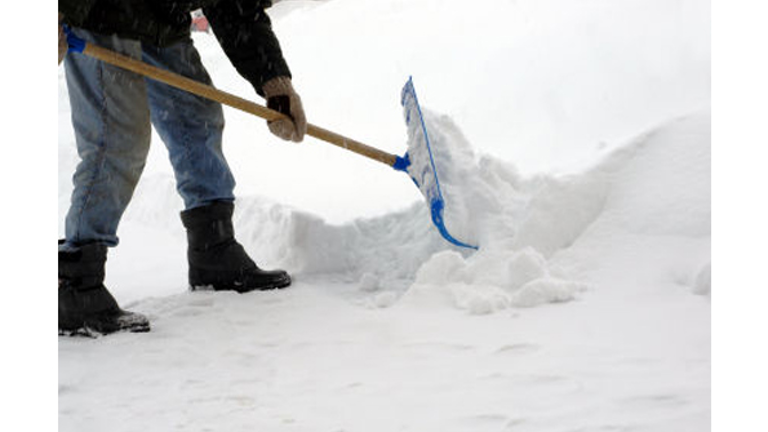
As always, maintaining regular physical activity is important in Injury Prevention. Regular exercise helps to promote stronger muscles and bones, which can help to prevent falls or limit the number of complications following a fall. Taking up a winter activity may be a good way of working exercise into your daily routine. Whether it is cross country skiing, skiing/snowboarding, skating, or hiking, all are good options for winter activity. If cold weather isn’t your thing, then there are also plenty of options for indoor exercise.
One good thing that has come out of the COVID-19 Pandemic is exercise accessibility. There are now plenty of free exercise routines on YouTube. If you’re still working, “Deskercise” is also an option. This is an exercise routine designed to promote improved posture and spinal mobility when seated at your computer or workstation. As always, if there is an ailment that you’re suffering from or any other concern, we are always available to assist you in developing a targeted exercise program to address your goals.
Dr. Cassie Zanolini, PT, DPT, at
WWS Physical Therapy and Vestibular Rehabilitation
Doylestown, Pennsylvania
215.489.3234
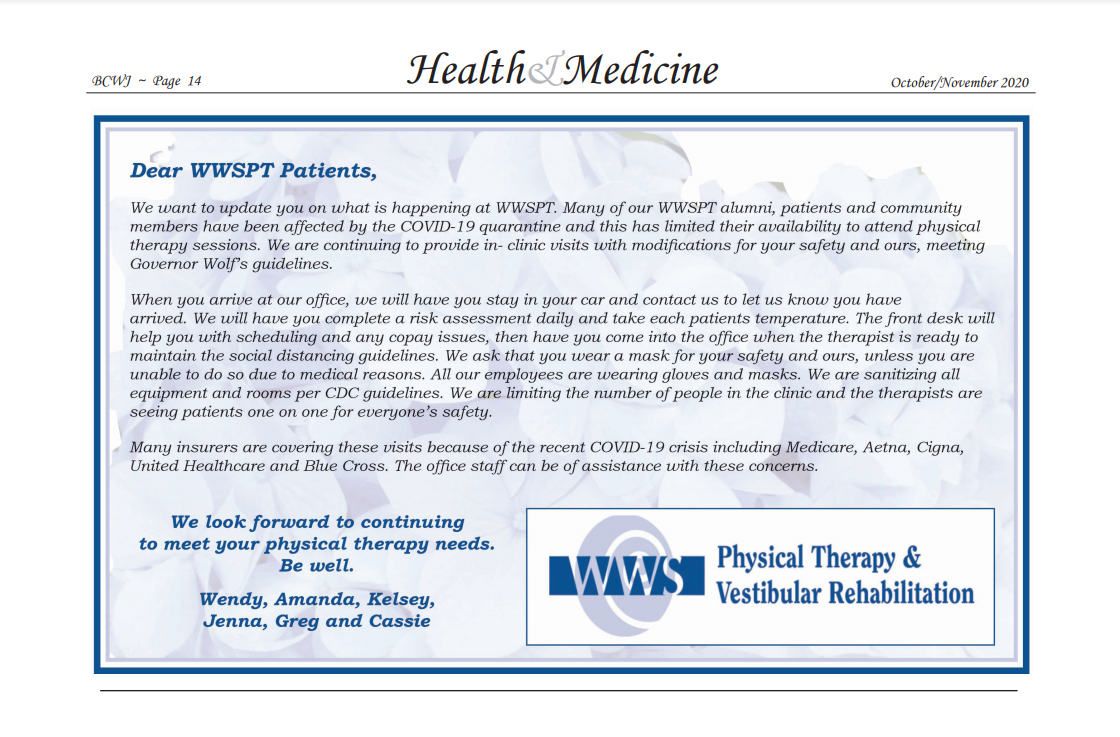
We strive to provide an environment of recovery and healing for our clients, to allow them to advance their health and return to function, recreation or sports. It is our belief that Physical Therapy is the initial link in the healthcare system for Musculoskeletal and Balance related issues and we are the true experts on exercise. We look forward to a long term relationship with our patients and their families over their life span and hope to become their practitioner of choice for acute musculoskeletal issues, neuromuscular issues as well as reoccurring events limiting their Wellness. We want to be a part of our patients Healthy living and Healthy aging.